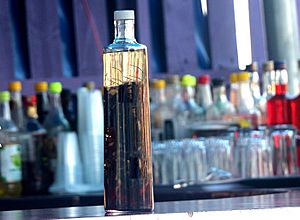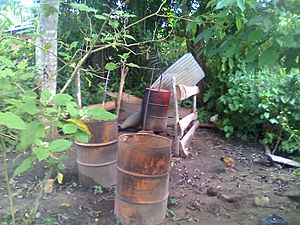Akpeteshie facts for kids

Akpeteshie infused with herbs
|
|
| Type | Liquor |
|---|---|
| Country of origin | Ghana |
| Alcohol by volume | 30–60% |
| Proof (US) | 60°–120° |
| Colour | clear |
| Ingredients | Palm wine |
| Related products | Ogogoro |
Akpeteshie is a traditional drink from West Africa, especially popular in Ghana. It is known as the national drink of Ghana. People make it by distilling liquids from palm wine or sugarcane. In Nigeria, this drink is called Ògógóró (Ogog'). It's often made locally from the juice of Raffia palm trees. This drink is a very old and important part of the culture in these regions.
Akpeteshie has many different names across West Africa. Some of these names include apio, ogoglo, ogogoro, VC10, Efie Nipa, and Kele. In Nigeria, it's also known as sapele water, kparaga, kai-kai, and OHMS (Our Home Made Stuff). These names often show how people feel about the drink or where it comes from.
Contents
History of Akpeteshie
Before European countries came to colonize what is now Ghana, the Anlo people already made a local drink. They called it "kpótomenui," which means "something hidden in a coconut mat fence."
When the British colonized the area, which they called the Gold Coast, they made it illegal to brew local drinks like akpeteshie. This ban started in the early 1930s. People at the time believed the British banned it to help sell their own imported drinks. So, people had to make and drink akpeteshie in secret. They still called it kpótomenui because it was hidden.
The name "akpeteshie" came from this time of hiding. It comes from the Ga language spoken in Accra. "Ape te shie" means "they are hiding." Even though it was against the law, many people still made and sold akpeteshie. The demand for it was so high that it encouraged farmers to grow more sugarcane in the Anlo region of Ghana.
After Ghana became independent from colonial rule, making akpeteshie became legal again. The first factory to produce it was built in the Volta Region. This area was chosen because it had many sugarcane farms.
How Akpeteshie is Made
Akpeteshie is made from the juice of Raffia palm trees or sugarcane juice.
- First, a cut is made in the trunk of a palm tree.
- A container is placed to collect the sap (juice) that drips out. This sap is collected after a day or two.
- Next, the sap is boiled to create steam.
- This steam then cools down and turns back into a liquid. This process is called distillation.
- The collected liquid is the akpeteshie. It is a natural product that is distilled.
Brewing Process
The process of making akpeteshie involves a few steps:
- The sweetened liquid from palm wine or sugarcane juice is first put into large barrels.
- Sometimes, yeast is added to help the liquid ferment. This is the first stage of fermentation.
- After fermentation, fires are lit under the barrels to make the liquid boil.
- The steam from the boiling liquid goes through a copper pipe.
- This pipe is inside cooling barrels, which makes the steam turn back into liquid.
- The liquid then drips into jars.
- The final drink usually has about 40 to 50% alcohol.
Packaging and How it's Used
Akpeteshie is usually not bottled in fancy, sealed bottles. Instead, it's often poured into used bottles without labels. You can buy it in large amounts from the people who make it. You can also buy it by the glass at small shops and bars.
Even though it's not advertised like other drinks, akpeteshie is very popular. One reason is its price. It is usually cheaper than other bottled or imported drinks. Because it's affordable, it's often linked with people who have less money. However, even people who can afford more expensive drinks are said to enjoy akpeteshie in private.
Cultural Importance
Akpeteshie, or ogogoro, is very important in the culture and economy of Nigeria. It plays a big part in many religious and social events.
- For example, priests of the Burutu (Ijaw) pour it on the ground as an offering to their gods.
- Fathers of Nigerian brides use it in a special ceremony to give their blessing to a wedding.
The economic side of ogogoro has also been very important in Nigeria's history. Many families who are not wealthy make this drink at home to earn money. They often sell small amounts on city street corners. When the colonial government made ogogoro illegal, it was partly to control local economic activities. They wanted to make sure people focused on jobs that benefited the colonial system.
Images for kids
See also
 In Spanish: Akpeteshie para niños
In Spanish: Akpeteshie para niños




